\You may be asking yourselves, “Why is she writing about containers now?” The answer is that spring sneaks up on us and many of the catalogs that are appearing in our mailboxes have plant combinations that they will sell you. Take a close look at them and decide whether and why you like them or don’t like them. Then devise combinations of your own. To help you do this, I have some advice.
Container gardening is characterized by great versatility. It is suitable for virtually every site or style you may encounter; it can even provide green space where it would have been otherwise impossible to garden.
Understanding the nuances of a perennial garden which evolves as well as an annuals garden which is static is helpful in combining both in a container. Using perennials and ornamental grasses, but leaving space for annuals, gives you a head start in spring.

Round container calls attention to path and echoes curvilinear theme
Since containers can be placed virtually anywhere, the next step is determining where to place them. This will be influenced by your overall goals- are you looking to add additional color; draw attention to or away from a certain feature; or create a green space in a barren area? Be aware that directional location is also crucial. Placement of a container facing south or west will necessitate much more frequent watering than one on a north or east wall.
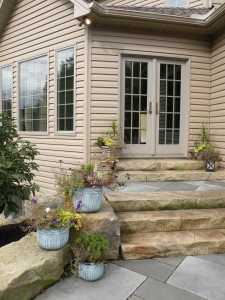
Containers on stair steps
Containers should be placed in prominent locations so that they can enhance their surroundings and selected to complement the surrounding area. . Put them on either side of a doorway, on a patio or deck, or on stairs, being careful to coordinate the colors of the pots and the plants in them with the color of the hardscaping. Containers are also very effective when integrated into the garden.
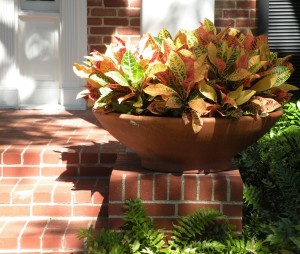
Terracotta bowl with Croton
Determine whether the container is going to be distinct from the plants or blend into the overall display. Terracotta pots on brick steps or patios look wonderful while wooden tubs or barrels on a deck or against a wood background are excellent choices.
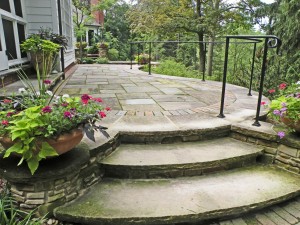
Round containers on either side of arching steps
Another consideration is the shape of the hardscaping. A round bed in the middle of a brick walk, for instance, cries out for a round container. So do a curvilinear patio and steps. Watering needs can also influence the size and type of container. The larger the container, the greater the soil mass and thus a lesser need to water as frequently.
There are innumerable choices for selecting pots, limited only by your imagination. Terracotta is available in a wide range of sizes and styles, from very simple to very ornate. The one drawback of terracotta is that it cannot be left outside during the winter. For small containers, this is not a problem but trying to carry large ones inside for the winter and then back out each spring is both time consuming and back breaking.
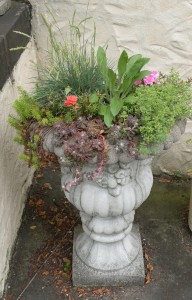
A concrete pedestal container that has been on my front porch for at least fifteen years.
An excellent alternative is a concrete or fiberglass container. Such containers are now readily available in beautiful patterns that have been cast from molds of old European containers. Plastic is another possibility, its primary virtue being its lack of weight. If you haunt antique shows, flea markets or salvage yards, you may find any number of items that could be used as containers such as lead urns, copper boilers or whatever else your creativity can convert to use.
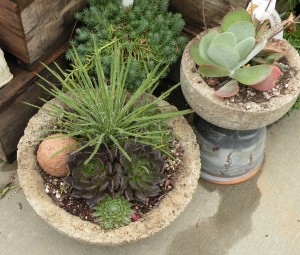
Tufa troughs used for succulents and Agave
Troughs are especially appropriate for alpine or dwarf plants since it is easier to create the particular soil mix necessary for them in a small confined area than to amend the soil in a garden. Troughs also work well for Sempervivum and small plants that might get lost in a large garden.

Container grouping of evergreens in different sizes of terracotta pots
Sometimes, containers are used as we would a specimen plant but more often we group them. Grouped pots will be more effective if similar in form but different in size. In addition, there should be some unifying plant element such as a particular genus and species or a particular color of foliage or flower. I find repetition of foliage color to be especially effective. For shady areas, a series of pots filled with variegated foliage would repeat the plant material in color but different forms.
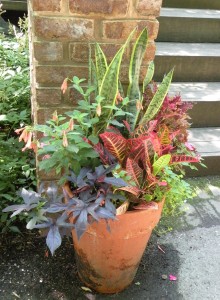
Container combo for bright light: Sanseviera, Abutilon, Croton, Ipomoea ‘Blackie’
In designing what goes into these containers, we apply the same principles as those we apply in our gardens: unity and balance. Unity is easily achieved with repetition of either size, color, form or texture of both bloom and foliage. Balance is the other crucial ingredient in creating eye catching container compositions. To achieve balance, it is necessary to carefully select plants for their height and width relative to the size of the container. Some plants, usually the ones in the back or center, depending on the angle from which the container is viewed, should be at least as high as the container. Then they should be combined with plants that will mound and trail.
With its versatility and unique design considerations, container gardens provide a wonderful opportunity to let our imagination and creative spirit run a bit wild.


1 Comment